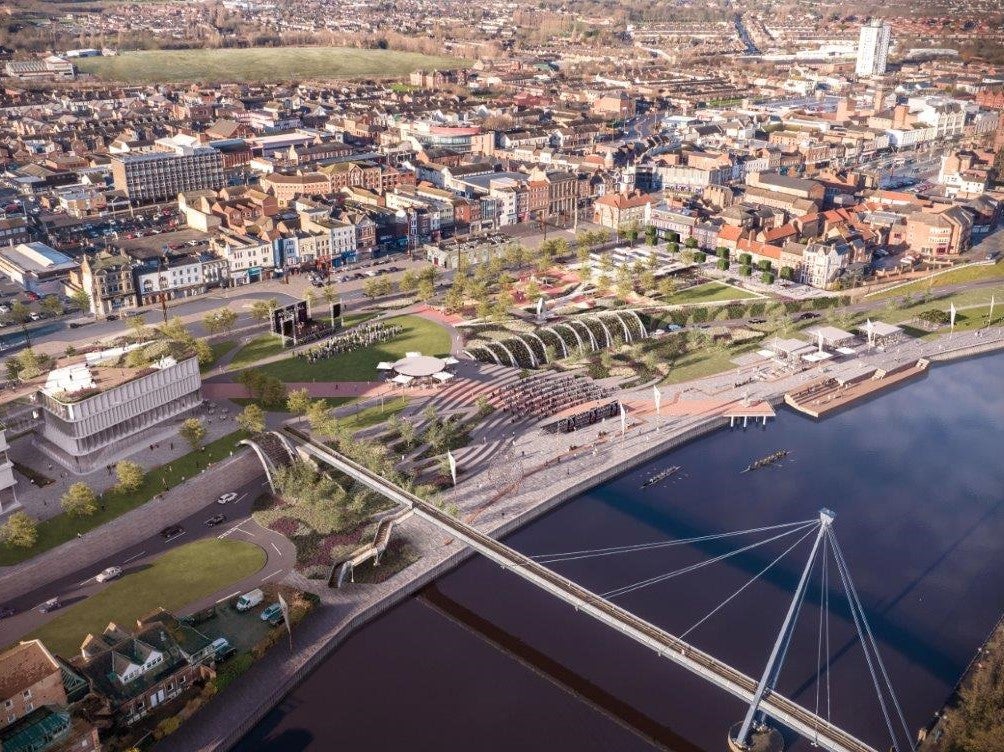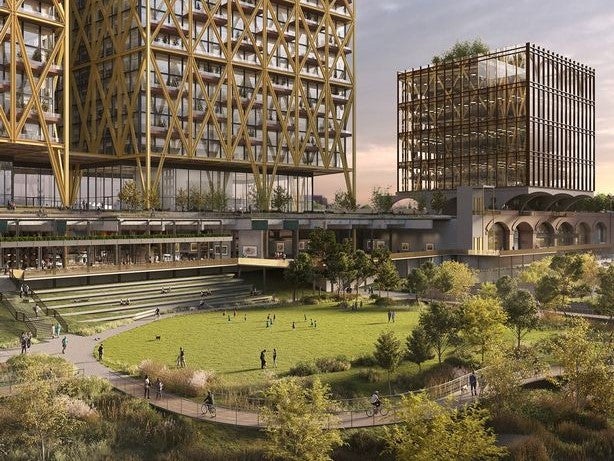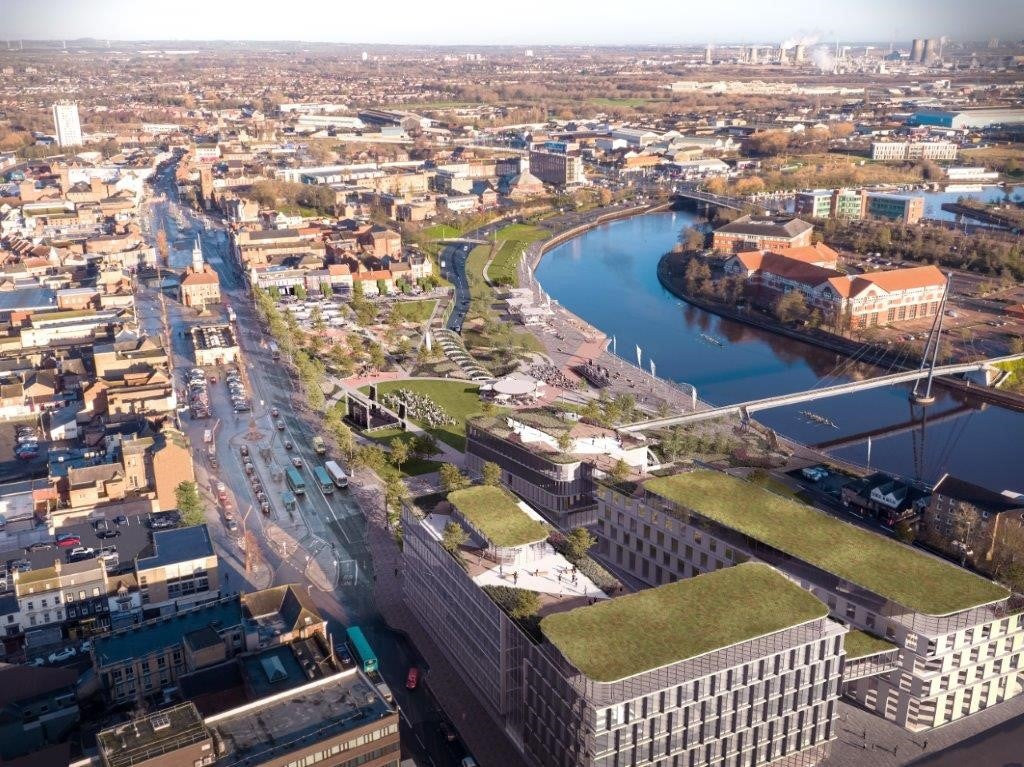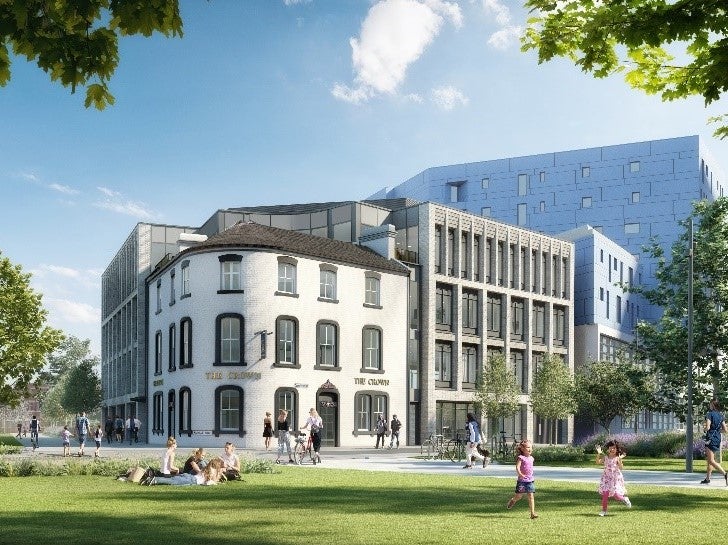A park in place of the high street: Could going green revive Britain’s flagging town and city centres?
Across the UK, parks are being planned for sites once earmarked for commercial development. Could this really this signal a new future for our urban landscape, asks Colin Drury


It is a transformation which will make the northeast town of Stockton-on-Tees almost unrecognisable – and which may, advocates say, signal a new future for British towns and cities.
Next year, the sprawling Castlegate shopping centre, which has dominated the high street here for half a century, will be demolished and replaced with a vast public park three times the size of Trafalgar Square.
The mall’s multi-storey car park and dozens of shops, as well as an adjacent hotel, will be bulldozed into history. In their place will come one of the North of England’s biggest urban oases: five acres of grassed lawns, wild habitats, play areas and picnic spots.
In an era of online shopping and struggling town centres – and amid both an ongoing pandemic and climate crisis – Stockton council has, it seems, decided that a park is the best route to sustainable civic regeneration.
“Is it risky?” ponders Nigel Cooke, cabinet member for regeneration and housing. “Yes, because nothing like this has really been done before in Britain. But it’s a measurable risk. Our view is we have to do something different – otherwise we are just managing [the town centre’s] decline.”
If the £37m vision – set to be officially approved next week – is unequivocally bold, it is only the most notable of a whole raft of similar projects currently being green-lit by various local authorities.
Across the UK, such outdoor spaces are being planned on sites previously earmarked for commercial development. In Sheffield, the 1.5-acre Pound Park is to be created where a car park and offices were previously pencilled in. In Leeds, the proposed Aire Park – part of a wider development of apartments and hotels – will become the city’s biggest new green space since the Victorian age. In Manchester, readjusted plans to regenerate the old Mayfield railway depot will now see a 6.5-acre oasis at its heart, albeit one surrounded by high-rise towers.
It all raises an intriguing prospect: after decades when the prevailing trend has been one of loss, could we now be seeing the first signs of a new golden age of park building? And could such facilities be key to transforming the flagging fortunes of our urban centres?

Between 2001 and 2019, eight per cent of urban green land was lost in the UK, according to estimates by the Committee on Climate Change. A 2015 Fields In Trust survey found one in six people feared their local park was at risk.
To what extent this pattern has been reversed (or not) since then is hard to assess, but experts with the Landscape Institute and Fields In Trust, as well as leading academics in green infrastructure, have all told The Independent there is now a growing sense that a shift has happened; that the value of such urban havens is being recognised in a way it simply never was before. Just look at Liverpool for proof: in March, every single one of the city’s parks was granted legal protection, safeguarding against all future development.
“Anecdotally, yes, I think this is happening,” says Benjamin Brown, head of policy and insight at the Landscape Institute. “There is no wholly robust data set on this, but there is certainly a gaining awareness of the value of green spaces... and that does appear to be driving [the creation of] more new parks.”
There are good reasons for this. Firstly, the mental and physical health benefits of parks have never felt more germane than on the back of Covid-19. Secondly, in the increasingly urgent climate crisis, their use in combating global warming and flood risk has never been more crucial. Indeed, the government has made “greening our towns and cities” a key plank of its 25-year plan on the environment.
But there is a third, perhaps less obvious, reason: the park as an economic driver. There is a widening belief that attractive and well-integrated public spaces are a hugely effective way of generating footfall, attracting investment and boosting surrounding property prices. There is some contention that one downstream effect of a good park is local job creation.
“They are almost being viewed as like anchor stores, as a way of bringing people into a certain part of town,” says Dr Danielle Sinnett, director of the Centre for Sustainable Planning and Environments at the University of the West of England.
Previously, she reckons, there was some tendency for green space to be tagged onto the end of developments where land was left over. Not so much any more. “Now it is being seen as key infrastructure in and of itself,” she says.

This is the thinking in Stockton, where the vast new park will be bordered on one side by the River Tees and on the other by a remodelled high street, including new retail units, restaurants, council offices and library.
Few would argue that this town of 95,000 is in need of regeneration. Thirty per cent of retail units are empty and major chain stores have abandoned the place over the past few years. The Seventies-built Castlegate was not only under-used, it was widely disliked. In a public consultation, 80 per cent of respondents wanted it knocked down.
“We’re no different to towns up and down the country in facing really severe shop closures and a struggling high street,” says councillor Nigel Cooke. “But we’re perhaps a bit ahead of the game because we started thinking about this when Woolworths closed [in 2009] … The future can be rosy but you’ve got to get that footfall, otherwise you’ve got a problem.
“In Stockton, for 30 years, we’ve been creating a really good events and experiences programme – because we’ve always had to compete with other towns in the Tees Valley to stand out – so the aim is to build on that by creating this wonderful open venue.”
It will not simply be a green space, he declares: “It will be a destination.”
Work is scheduled to begin early next year, and there are already suggestions it could be copied across the Tees in nearby Middlesbrough. There, more shop closures are inevitable, the town’s regeneration chief Richard Horniman said earlier this month. “It might mean we have to flatten some [streets] and put an urban park there,” he told a meeting of Middlesbrough council. “It’s happening in Stockton and it might have to happen here.”
It seems unlikely that authorities in other towns and cities will not come to a similar conclusion in the coming years.

Yet if all this does indeed suggest we are entering a new era of park creation, experts suggest any optimism must be tempered.
Outside of urban centres, green space is still being eaten up by development at a significant rate, while parks that already exist within towns and cities lost so much funding during the decade of austerity that there are now widespread difficulties in maintaining them. Because providing such facilities is not a statutory obligation for local councils, park budgets are often among the first to get slashed during times of hardship.
“You can have lots of green space everywhere but, if it’s not a quality standard, we are not maximising the benefits,” says Dr Anna Barker, co-founder of the International Parks and Green Spaces Research Portal. “So there does need to be a new vision which might include new core funding.”
Such funding, she adds, must recognise that money spent on parks now is money saved down the line on, for example, NHS and social care bills.
There are also concerns about the iniquity of access to such havens. Those living in high-deprivation districts are far less likely to have parks in walking distance than residents of more affluent areas. A 2020 report by Friends of the Earth found 40 per cent of black and ethnic minority people lived in England’s most green space-deprived areas, compared to 14 per cent of white people. It labelled this the “green space gap” and urged ministers to work at levelling up the disparity.
Only when this is done, and only when funding is guaranteed for ongoing investment in both new and existing parks – only then – will we truly be able to say we are seeing a new golden era of urban green spaces.
Join our commenting forum
Join thought-provoking conversations, follow other Independent readers and see their replies
Comments
Bookmark popover
Removed from bookmarks